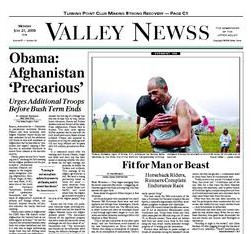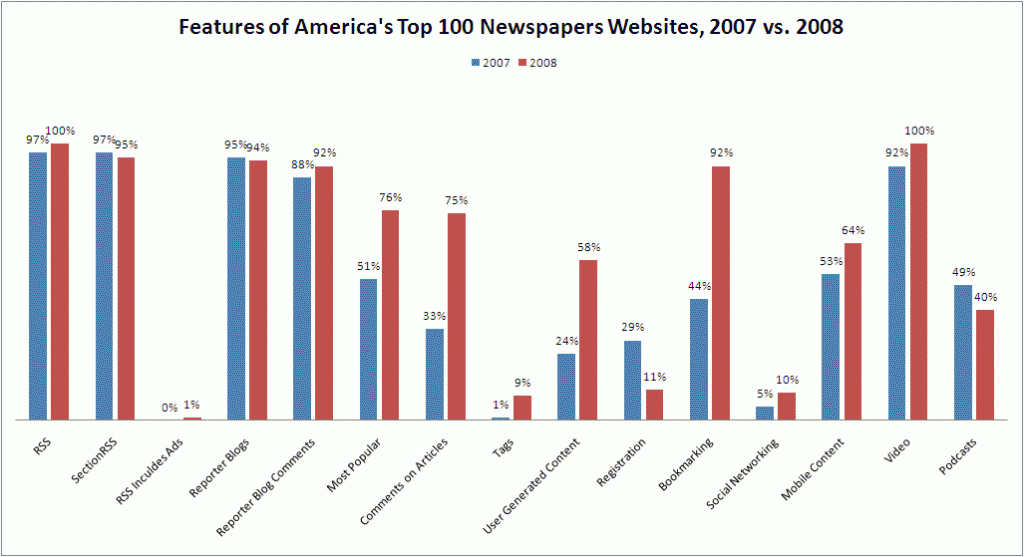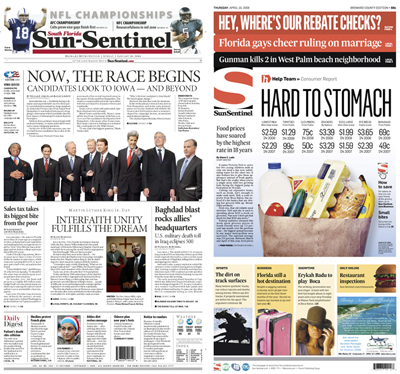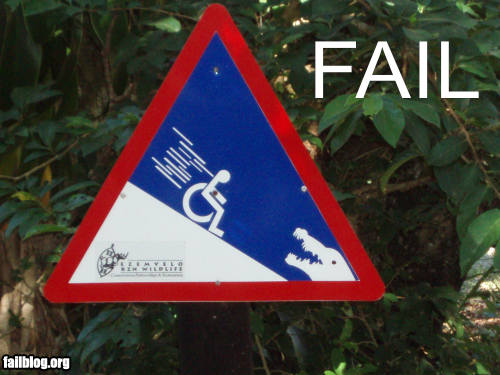It looks like 2009 will be a make-or-break year for many media companies, thanks to an advertising climate the some forecasters are predicting will the worst in generations.
Media economist Jack Myers is predicting an “advertising depression,” says Dow Jones. “Myers, a longtime industry consultant who runs JackMyers.com, is now forecasting an unprecedented three straight years of declines in advertising and marketing spending in the U.S. starting this year,” the wire service says. “To put that in perspective, the industry hasn’t suffered even a two-year spending decline in advertising since the 1930s.” The result will be a “massive shakeout” in industries that depend on advertising for their livelihood. Myers expects advertising spending in the U.S. to call 2.4% this year, 6.7% next year and 2.3% in 2010. His forecast roughly agrees with estimates by Publicis Groupe. The downturn will make it more difficult for media companions to effect the transformations that are necessary to survive in the customer-driven marketing environment of the future.
Meanwhile, Barclays Capital expects domestic ad spending to drop 10% next year, which is dramatically worse than performance during both the 1991 and 2001 recessions. The forecast is a substantial revision of Barclays’ prediction just two months ago that next year’s decline would be a less-drastic 5.5%. The investment bank sees trouble in the local advertising industry, which is often seen as the best hope for newspaper salvation. Local spending, which makes up some 39% of the $252.1 billion U.S. ad market, will fall 12.2% in 2009, while national spending will drop 8.4%. Barclays forecast that local ad spending would decline an additional 1.4% even when the broader market recovers in 2010. The one positive note: Internet advertising should increase 6.1% in 2009 and 12% in 2010, but that segment will still account for just 10% of ad spending next year.
Given those forecasts, it’s not surprising that asset values have tanked. “Some 30 US newspapers are up for sale…but few buyers have emerged in spite of rock bottom prices,” notes the Financial Times. Valuations have fallen by at least half compared to their highs and signs that the advertising environment is worsening aren’t helping, the paper says. To illustrate the degree of loss in asset values, the Boston Globe was valued at $650 million by a consortium of buyers just two years ago. Today, the value of the Globe and the Worcester (Mass.) Telegram & Gazette combined is just $120 million. In fact, The New York Times Co.’s most valuable New England asset may be its equity stake in the Boston Red Sox. It was worth about $135 million before the financial crisis hit. And that’s without Mark Teixeira.
Some Good News, Too
While admitting that 2009 will be a mostly crummy year for the economy, Poynter Media Business Analyst Rick Edmonds sees reasons to believe better days are ahead. For one thing, oil is comparatively cheap right now and the price of paper is coming down. While you shouldn’t get comfortable with short-term trends in these commodities, at least they are two fewer factors weighing on the industry. The buyouts and layoffs of 2008 will show also benefits in 2009 as newspapers remove those costs from their books. And there are promising signs in newspapers’ online activities that may broadly benefit the industry. Edmonds is careful to hedge his bets, but he wants to exit the year on a positive note.
Cuts Take Toll on Quality
Print editors are accustomed to getting letters from readers taking them to task for erroneously saying the California Gold Rush started in 1845 instead of 1848 and concluding, “Shoddy fact-checking like this makes me skeptical of anything you report in your journal.” Editors usually laugh off these missives, but with readers enjoying a bounty of choice these days and freely publishing their own critiques, the gaffes caused by overworked news staffs potentially become more damaging. Detroit NASCAR Examiner Josh Lobdell points out three major errors in a Detroit News story and questions how a newspaper in the Motor City can do such a shoddy job of covering motoring. The Sunday Business Post of Ireland restates almost verbatim what we suggested 2 1/2 years ago: that the cycle of cutbacks will lead to inferior products that people won’t want to read, which will harm circulation and lead to more layoffs. You don’t cost-cut your way to leadership.
 If errors are your thing, read Craig Silverman’s year-end column in the Toronto Star about the worst publishing gaffes of 2008. Our favorite is the AP’s reference to Joseph Lieberman as a “Democratic vice-presidential prick.” There are plenty more on Silverman’s awesome blog, Regret the Error. Be sure to read his annual celebration of the worst errors and corrections in the media, an award he calls the Crunks. One of the best has to be this front page of northern New England’s Valley News, which actually managed to misspell its own name on its front page one day.
If errors are your thing, read Craig Silverman’s year-end column in the Toronto Star about the worst publishing gaffes of 2008. Our favorite is the AP’s reference to Joseph Lieberman as a “Democratic vice-presidential prick.” There are plenty more on Silverman’s awesome blog, Regret the Error. Be sure to read his annual celebration of the worst errors and corrections in the media, an award he calls the Crunks. One of the best has to be this front page of northern New England’s Valley News, which actually managed to misspell its own name on its front page one day.
Report: Newspaper Sites Embrace Web Tools
The Bivings Group examined the websites of the 100 top U.S. newspapers to see what they’re doing with the Internet. While a few activities have changed little over the last year (RSS, reporter blogs and video), there have been striking increases in the use of some features:
- Fifth-eight percent of newspaper websites post user-generated photos, 18% accept video and 15% publish user-generated articles. That’s way up from the 24% that accepted such material in 2007.
- Seventy five percent now accept article comments in some form, compared to 33% in 2007.
- Facebook-like social networking tools are beginning to gain traction, with 10% of newspapers now using them, or double last year’s figure.
- Three-quarters list some kind of most-popular ranking, such as most e-mailed or most commented. Just 33% had that feature in 2006.
- You can now submit articles to social bookmarking sites like Digg and del.icio.us at 92% of newspaper sites, compared to only 7% in 2006.
- Only 11% of websites now require registration to view full articles, compared to 29% last year.
- Other stats: 57% have PDF editions, 20% have chat, and 40% offer SMS alerts.
Don’t strain your eyes: Click the image below for a larger version. More charts and data is in the summary report.

Miscellany
Journal-Register has reportedly closed a chain of Connecticut weeklies. The North Haven Courier reports, “On Dec. 18, members of [the Shore Line and Elm City Newspapers, a weekly newspaper chain in the shoreline and Greater New Haven area] were notified they had been laid off…The affected papers include the North Haven Post, the East Haven Advertiser, the Branford Review, the Shore Line Times of Guilford and Madison, the Clinton Recorder, and the Pictorial Gazette and Main Street News in Westbrook, Old Saybrook, Essex, Deep River, Chester, Lyme, and Old Lyme…Joyce Mletschnig, who until Thursday was the Pictorial Gazette’s associate editor, said that their newspapers would be shut down.”
The Seattle Times is asking about 500 non-unionized employees to take a week’s unpaid vacation in order to avoid more layoffs. Employees can take the seven days off at any time over the next two months. Management at the Times, which has cut 22% of its staff this year, may believe that further layoffs will undermine quality to too great a degree, so it’s getting creative with strategy.
Russ Smith has some good quotes in a piece on Splice Today about what he believes is the inevitable demise of print newspapers. Smith, 53, is an unabashed newspaper fan but he’s noticed that even his contemporaries are dropping their print subscriptions or not noticing when the paper no longer arrives on the doorstep. He also notices that his kids and their friends are just as well-informed about current events as he, a counter to the conventional wisdom that young people don’t read. Smith boldly predicts that The New York Times will be sold by the end of 2009, with Rupert Murdoch on the short list of likely buyers. On the other hand, Murdoch may be content simply to let his nemesis fade away.
Raleigh News & Observer Staff Writer Mark Schultz writes with passion about why he got into newspapers and why they’re still relevant. His best line comes in an account about interviewing a woman in her trailer home in Mexico: “We enter people’s lives for an hour and ask for instant intimacy.”
The Knoxville News Sentinel has apparently managed to avoid the carnage that has devastated many of its brethren. In an upbeat column plainly titled “News Sentinel is NOT going out of business,” Editor Jack McElroy pays homage to owner E.W. Scripps Co. for shrewdly diversifying its revenue stream and not loading up on debt. He also says the News Sentinel wisely diversified into TV and specialty publishing to insulate itself from the newspaper advertising downturn. Critics naturally accuse the paper of selling out to political interests.
The New York Times will launch “Instant Op-Ed” next month in a bid to compete with instant cable television analysis. The Web feature will post immediate expert viewpoints on breaking news, according to Editorial Page Editor Andrew Rosenthal.
And Finally…
The Baltimore Sun’s John McIntyre asked readers to contribute the best line heard in the workplace. They come through with some winners. Our favorite: “Yeah, he thinks he’s God’s gift to sliced bread.”
 The cure for the newspaper industry’s ills was once thought to be a “hyper-local” focus, but that’s not proving to be the salve for New York City, which is suffering an unprecedented decline in local news coverage. The latest casualty is the New York Daily News, which on Monday said it would cut its newsroom staff by half. The Washington Post points out that this means that a paper that employed 400 journalists in 1988 will have a reportorial staff of just 45 when the latest cuts new owner Tronc take effect.
The cure for the newspaper industry’s ills was once thought to be a “hyper-local” focus, but that’s not proving to be the salve for New York City, which is suffering an unprecedented decline in local news coverage. The latest casualty is the New York Daily News, which on Monday said it would cut its newsroom staff by half. The Washington Post points out that this means that a paper that employed 400 journalists in 1988 will have a reportorial staff of just 45 when the latest cuts new owner Tronc take effect.





